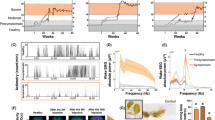Mice with previously implanted electrodes for recording the cortical electroencephalogram and electromyograms underwent all-day baseline videopolysomnography with a 12/12 light cycle, after which animals received doses of 24 or 48 mg/kg of the neurotoxin precursor MPTP (1-methyl-4-phenyl-1.2.3.7-tetrahydropyridine) or physiological saline (controls) and recording was continued for 14 days. At the end of the experiments, morphological monitoring of the extent of lesions to the dopaminergic system was performed. Increases in motor activity and the total duration of waking during the dark part of the night were seen after administration of MPTP, as compared with controls. These changes were accompanied by decreases in the durations of rapid and (at the level of a tendency) slow-wave sleep. These changes were apparent by recording day 7 and were significant by day 14; they were more marked after treatment at a dose of 48 mg/kg than after the smaller dose. No changes were seen during the light period of the day. Morphological monitoring demonstrated a 70% reduction in the number of dopamine-containing neurons in the compact zone of the substantia nigra after administration of MPTP (48 mg/kg) and a 35% drop after MPTP (24 mg/kg).
Similar content being viewed by others
References
V. M. Koval’zon, “The brain and sleep: from neurons to molecules,” Zh. Vyssh. Nerv. Deyat., 73, No. 1, 48–70 (2013).
V. M. Koval’zon, “The role of the histaminergic system of the brain in regulating the sleep–waking cycle,” Fiziol. Cheloveka, 39, No. 7, 13–23 (2013).
V. M. Koval’zon, “Central mechanisms of regulation of the sleep–waking cycle,” Fiziol. Cheloveka, 37, No. 4, 124–134 (2011).
V. M. Koval’zon and I. M. Zavalko, “The sleep–waking cycle and Parkinson’s disease,” Neirokhimiya, 30, No. 3, 193–207 (2013).
Yu. F. Pastukhov, “Changes in the characteristics of paradoxical sleep– an early sign of parkinsonism,” Zh. Vyssh. Nerv. Deyat., 73, No. 1, 75–85 (2013).
O. Sacks, Awakenings [Russian translation], Astrel, Moscow (2013).
C. Blanco-Centurion, D. Gerashchenko, and P. J. Shiromani, “Effects of saporin-induced lesions of three arousal populations on daily levels of sleep and wake,” J. Neurosci., 27, No. 51, 14041–14048 (2007).
K. Fifel, O. Dkhissi-Benyahya, and H. M. Cooper, “Lack of longterm changes in circadian, locomotor, and cognitive functions in acute and chronic MPTP (1.2.3.7-tetrahydropyridine) mouse models of Parkinson’s disease,” Chronobiol. Int., 30, No. 7, 741–755 (2013).
A. Iranzo, “Sleep-wake changes in the premotor stage of Parkinson disease,” J. Neurol. Sci., 310, 283–285 (2011).
C. Laloux, P. Derambure, J.-M. Jacquesson, et al., “The effects of serotoninergic, noradrenergic, cholinergic and dopaminergic drugs on vigilance states in MPTP-treated mice,” Brain Res., 117, 79–87 (2007).
C. Laloux, P. Derambure, A. Kreisler, et al., “MPTP-treated mice: long-lasting loss of nigral TH-ir neurons but not paradoxical sleep alterations,” Exp. Brain Res., 187, 735–742 (2008).
W. Le, P. Sayana, and J. Jankovic, “Animal models of Parkinson’s disease: A gateway to therapeutics?” Neurotherapeutics, 11, 92–110 (2014).
M. S. M. Lima, “Sleep disturbances in Parkinson’s disease: The contribution of dopamine in REM sleep regulation,” Sleep Med. Rev., 17, No. 5, 377–375 (2012).
C. Monaca, C. Laloux, J.-M. Jacquesson, et al., “Vigilance states in a parkinsonian model, the MPTP mouse,” Eur. J. Neurosci., 20, No. 9, 2474–2478 (2004).
J. Peever, P.-H. Luppi, and J. Montplaisir, “Breakdown in REM sleep circuitry underlies REM sleep behavior disorder,” Trends Neurosci., 37, No. 5, 279–288 (2014).
I. Shpirer, A. Miniovitz, C. Klein, et al., “Excessive daytime sleepiness in patients with Parkinson’s disease: A polysomnography study,” Mov. Disord., 21, No. 9, 1432–1438 (2007).
M. V. Ugrumov, V. G. Khaindrava, E. A. Kozina, et al., “Modeling of presymptomatic and symptomatic stages of parkinsonism in mice,” Neuroscience, 181, 175–188 (2011).
Author information
Authors and Affiliations
Corresponding author
Additional information
Translated from Rossiiskii Fiziologicheskii Zhurnal imeni I. M. Sechenova, Vol. 100, No. 11, pp. 1252–1260, November, 2014.
Rights and permissions
About this article
Cite this article
Manolov, A.I., Dolgikh, V.V., Ukraintseva, Y.V. et al. Changes in Motor Activity and the Sleep–Waking Cycle in an MPTP Model of Parkinson’s Disease in Mice. Neurosci Behav Physi 46, 467–471 (2016). https://doi.org/10.1007/s11055-016-0259-0
Received:
Revised:
Published:
Issue Date:
DOI: https://doi.org/10.1007/s11055-016-0259-0




